ISO 9000 Certification Adoption: Key Determinants & Performance Impact
VerifiedAdded on 2023/06/12
|20
|4438
|397
Report
AI Summary
This report investigates the factors influencing the adoption of ISO 9000 certification and its subsequent impact on firm performance. The analysis encompasses a dataset of 5717 firms, differentiating between certified and non-certified entities across various industry sectors. Key determinants such as employee education levels, company assets, equity, capital sources, and company age are examined, alongside performance indicators like sales, profit, return on sales, return on assets, and overseas investment. The study employs frequency distributions, descriptive statistics, chi-square tests, and t-tests to assess associations and mean differences between certified and non-certified firms. Results indicate a strong association between industry type and certification status, significant differences in mean values for several impact variables, and higher mean sales and revenue in certified firms. The report provides insights into the motivations and outcomes associated with ISO 9000 certification, contributing to a deeper understanding of quality management practices and their effects on business performance. Desklib provides access to similar reports and solved assignments for students.
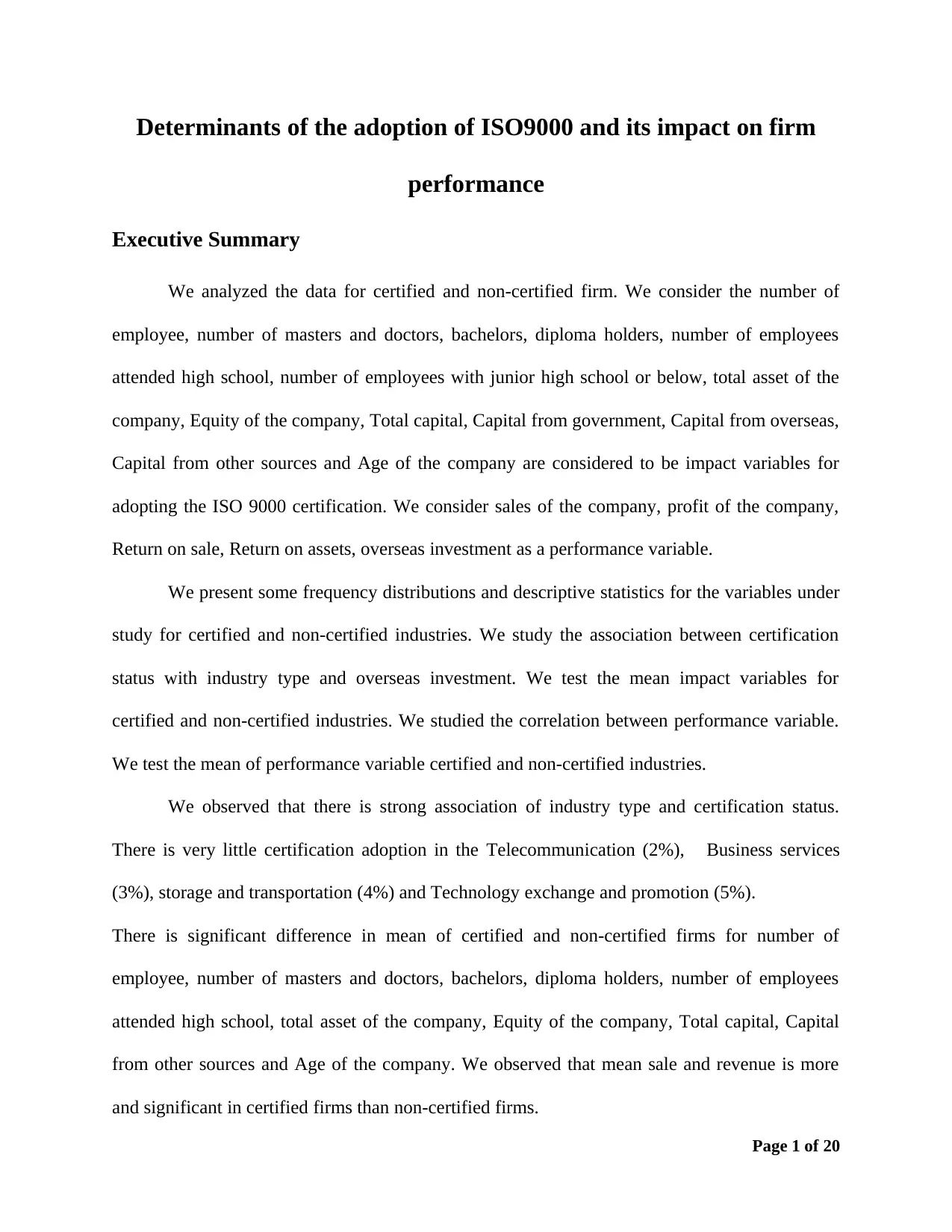
Determinants of the adoption of ISO9000 and its impact on firm
performance
Executive Summary
We analyzed the data for certified and non-certified firm. We consider the number of
employee, number of masters and doctors, bachelors, diploma holders, number of employees
attended high school, number of employees with junior high school or below, total asset of the
company, Equity of the company, Total capital, Capital from government, Capital from overseas,
Capital from other sources and Age of the company are considered to be impact variables for
adopting the ISO 9000 certification. We consider sales of the company, profit of the company,
Return on sale, Return on assets, overseas investment as a performance variable.
We present some frequency distributions and descriptive statistics for the variables under
study for certified and non-certified industries. We study the association between certification
status with industry type and overseas investment. We test the mean impact variables for
certified and non-certified industries. We studied the correlation between performance variable.
We test the mean of performance variable certified and non-certified industries.
We observed that there is strong association of industry type and certification status.
There is very little certification adoption in the Telecommunication (2%), Business services
(3%), storage and transportation (4%) and Technology exchange and promotion (5%).
There is significant difference in mean of certified and non-certified firms for number of
employee, number of masters and doctors, bachelors, diploma holders, number of employees
attended high school, total asset of the company, Equity of the company, Total capital, Capital
from other sources and Age of the company. We observed that mean sale and revenue is more
and significant in certified firms than non-certified firms.
Page 1 of 20
performance
Executive Summary
We analyzed the data for certified and non-certified firm. We consider the number of
employee, number of masters and doctors, bachelors, diploma holders, number of employees
attended high school, number of employees with junior high school or below, total asset of the
company, Equity of the company, Total capital, Capital from government, Capital from overseas,
Capital from other sources and Age of the company are considered to be impact variables for
adopting the ISO 9000 certification. We consider sales of the company, profit of the company,
Return on sale, Return on assets, overseas investment as a performance variable.
We present some frequency distributions and descriptive statistics for the variables under
study for certified and non-certified industries. We study the association between certification
status with industry type and overseas investment. We test the mean impact variables for
certified and non-certified industries. We studied the correlation between performance variable.
We test the mean of performance variable certified and non-certified industries.
We observed that there is strong association of industry type and certification status.
There is very little certification adoption in the Telecommunication (2%), Business services
(3%), storage and transportation (4%) and Technology exchange and promotion (5%).
There is significant difference in mean of certified and non-certified firms for number of
employee, number of masters and doctors, bachelors, diploma holders, number of employees
attended high school, total asset of the company, Equity of the company, Total capital, Capital
from other sources and Age of the company. We observed that mean sale and revenue is more
and significant in certified firms than non-certified firms.
Page 1 of 20
Paraphrase This Document
Need a fresh take? Get an instant paraphrase of this document with our AI Paraphraser
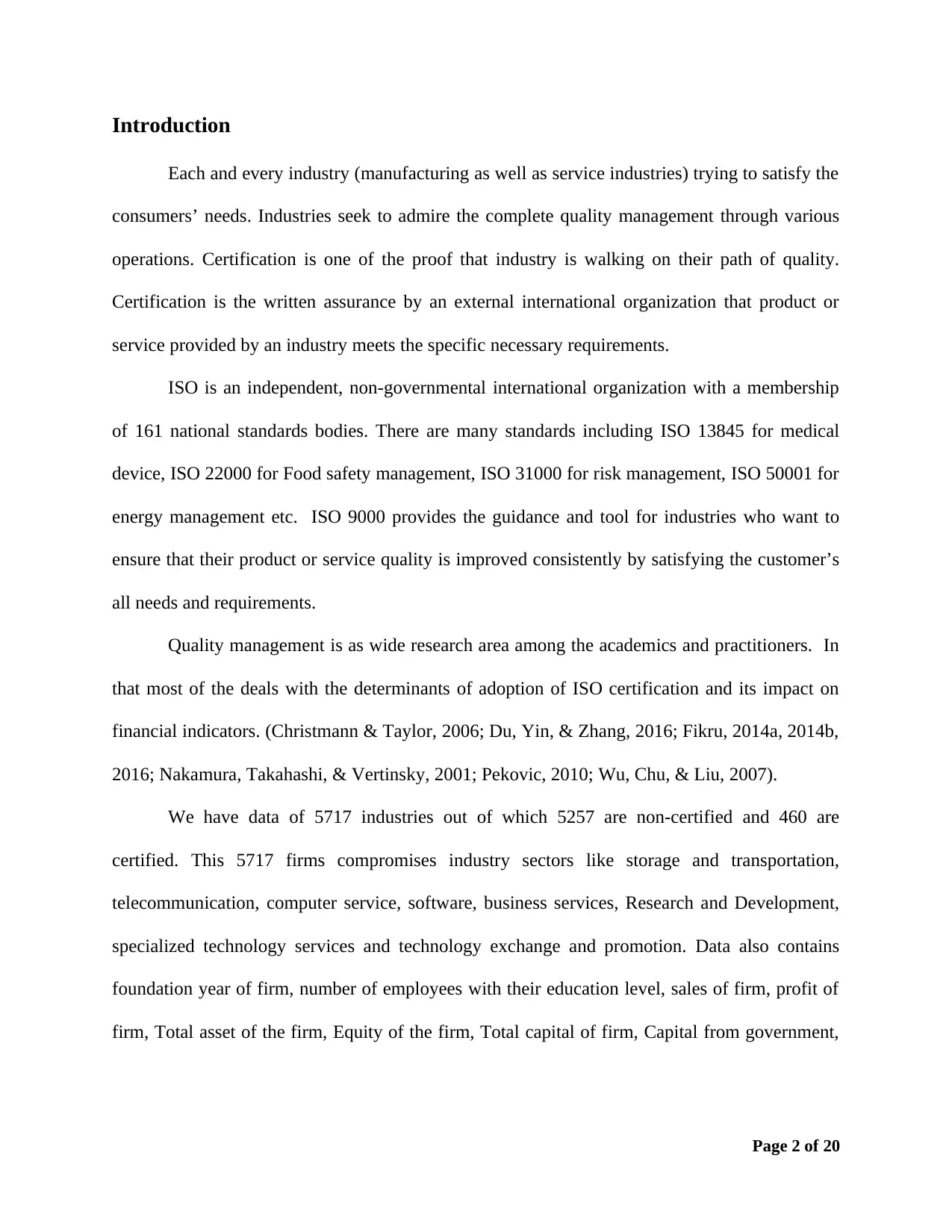
Introduction
Each and every industry (manufacturing as well as service industries) trying to satisfy the
consumers’ needs. Industries seek to admire the complete quality management through various
operations. Certification is one of the proof that industry is walking on their path of quality.
Certification is the written assurance by an external international organization that product or
service provided by an industry meets the specific necessary requirements.
ISO is an independent, non-governmental international organization with a membership
of 161 national standards bodies. There are many standards including ISO 13845 for medical
device, ISO 22000 for Food safety management, ISO 31000 for risk management, ISO 50001 for
energy management etc. ISO 9000 provides the guidance and tool for industries who want to
ensure that their product or service quality is improved consistently by satisfying the customer’s
all needs and requirements.
Quality management is as wide research area among the academics and practitioners. In
that most of the deals with the determinants of adoption of ISO certification and its impact on
financial indicators. (Christmann & Taylor, 2006; Du, Yin, & Zhang, 2016; Fikru, 2014a, 2014b,
2016; Nakamura, Takahashi, & Vertinsky, 2001; Pekovic, 2010; Wu, Chu, & Liu, 2007).
We have data of 5717 industries out of which 5257 are non-certified and 460 are
certified. This 5717 firms compromises industry sectors like storage and transportation,
telecommunication, computer service, software, business services, Research and Development,
specialized technology services and technology exchange and promotion. Data also contains
foundation year of firm, number of employees with their education level, sales of firm, profit of
firm, Total asset of the firm, Equity of the firm, Total capital of firm, Capital from government,
Page 2 of 20
Each and every industry (manufacturing as well as service industries) trying to satisfy the
consumers’ needs. Industries seek to admire the complete quality management through various
operations. Certification is one of the proof that industry is walking on their path of quality.
Certification is the written assurance by an external international organization that product or
service provided by an industry meets the specific necessary requirements.
ISO is an independent, non-governmental international organization with a membership
of 161 national standards bodies. There are many standards including ISO 13845 for medical
device, ISO 22000 for Food safety management, ISO 31000 for risk management, ISO 50001 for
energy management etc. ISO 9000 provides the guidance and tool for industries who want to
ensure that their product or service quality is improved consistently by satisfying the customer’s
all needs and requirements.
Quality management is as wide research area among the academics and practitioners. In
that most of the deals with the determinants of adoption of ISO certification and its impact on
financial indicators. (Christmann & Taylor, 2006; Du, Yin, & Zhang, 2016; Fikru, 2014a, 2014b,
2016; Nakamura, Takahashi, & Vertinsky, 2001; Pekovic, 2010; Wu, Chu, & Liu, 2007).
We have data of 5717 industries out of which 5257 are non-certified and 460 are
certified. This 5717 firms compromises industry sectors like storage and transportation,
telecommunication, computer service, software, business services, Research and Development,
specialized technology services and technology exchange and promotion. Data also contains
foundation year of firm, number of employees with their education level, sales of firm, profit of
firm, Total asset of the firm, Equity of the firm, Total capital of firm, Capital from government,
Page 2 of 20

Capital from overseas, Capital from other sources, Return on sales, Return on assets, percentage
of overseas investment in the total investment, Overseas investment and Age of the firm.
We analyzed the data for certified and non-certified firm. We consider the number of
employee, number of masters and doctors, bachelors, diploma holders, number of employees
attended high school, number of employees with junior high school or below, total asset of the
company, Equity of the company, Total capital, Capital from government, Capital from overseas,
Capital from other sources and Age of the company are considered to be impact variables for
adopting the ISO 9000 certification. We consider sales of the company, profit of the company,
Return on sale, Return on assets, overseas investment as a performance variable.
We present some frequency distributions and descriptive statistics for the variables under
study for certified and non-certified industries. We study the association between certification
status with industry type and overseas investment. We test the mean impact variables for
certified and non-certified industries. We studied the correlation between performance variable.
We test the mean of performance variable certified and non-certified industries.
Literature Review
In today’s world, industries with ISO Certification considered to be faithful industry.
There are variety of variables that can be affect the determinant of ISO certification. In literature,
there is huge amount of research is done in connection with determinants of firm participation in
ISO Certification and its impact on firm performance in all over the world. (Christmann &
Taylor, 2006; Du, Yin, & Zhang, 2016; Fikru, 2014a, 2014b, 2016; Nakamura, Takahashi, &
Vertinsky, 2001; Pekovic, 2010; Wu, Chu, & Liu, 2007). Fikru(2016) concludes that foreign
ownership, plant size and business communications through company website are vital for the
Page 3 of 20
of overseas investment in the total investment, Overseas investment and Age of the firm.
We analyzed the data for certified and non-certified firm. We consider the number of
employee, number of masters and doctors, bachelors, diploma holders, number of employees
attended high school, number of employees with junior high school or below, total asset of the
company, Equity of the company, Total capital, Capital from government, Capital from overseas,
Capital from other sources and Age of the company are considered to be impact variables for
adopting the ISO 9000 certification. We consider sales of the company, profit of the company,
Return on sale, Return on assets, overseas investment as a performance variable.
We present some frequency distributions and descriptive statistics for the variables under
study for certified and non-certified industries. We study the association between certification
status with industry type and overseas investment. We test the mean impact variables for
certified and non-certified industries. We studied the correlation between performance variable.
We test the mean of performance variable certified and non-certified industries.
Literature Review
In today’s world, industries with ISO Certification considered to be faithful industry.
There are variety of variables that can be affect the determinant of ISO certification. In literature,
there is huge amount of research is done in connection with determinants of firm participation in
ISO Certification and its impact on firm performance in all over the world. (Christmann &
Taylor, 2006; Du, Yin, & Zhang, 2016; Fikru, 2014a, 2014b, 2016; Nakamura, Takahashi, &
Vertinsky, 2001; Pekovic, 2010; Wu, Chu, & Liu, 2007). Fikru(2016) concludes that foreign
ownership, plant size and business communications through company website are vital for the
Page 3 of 20
⊘ This is a preview!⊘
Do you want full access?
Subscribe today to unlock all pages.

Trusted by 1+ million students worldwide
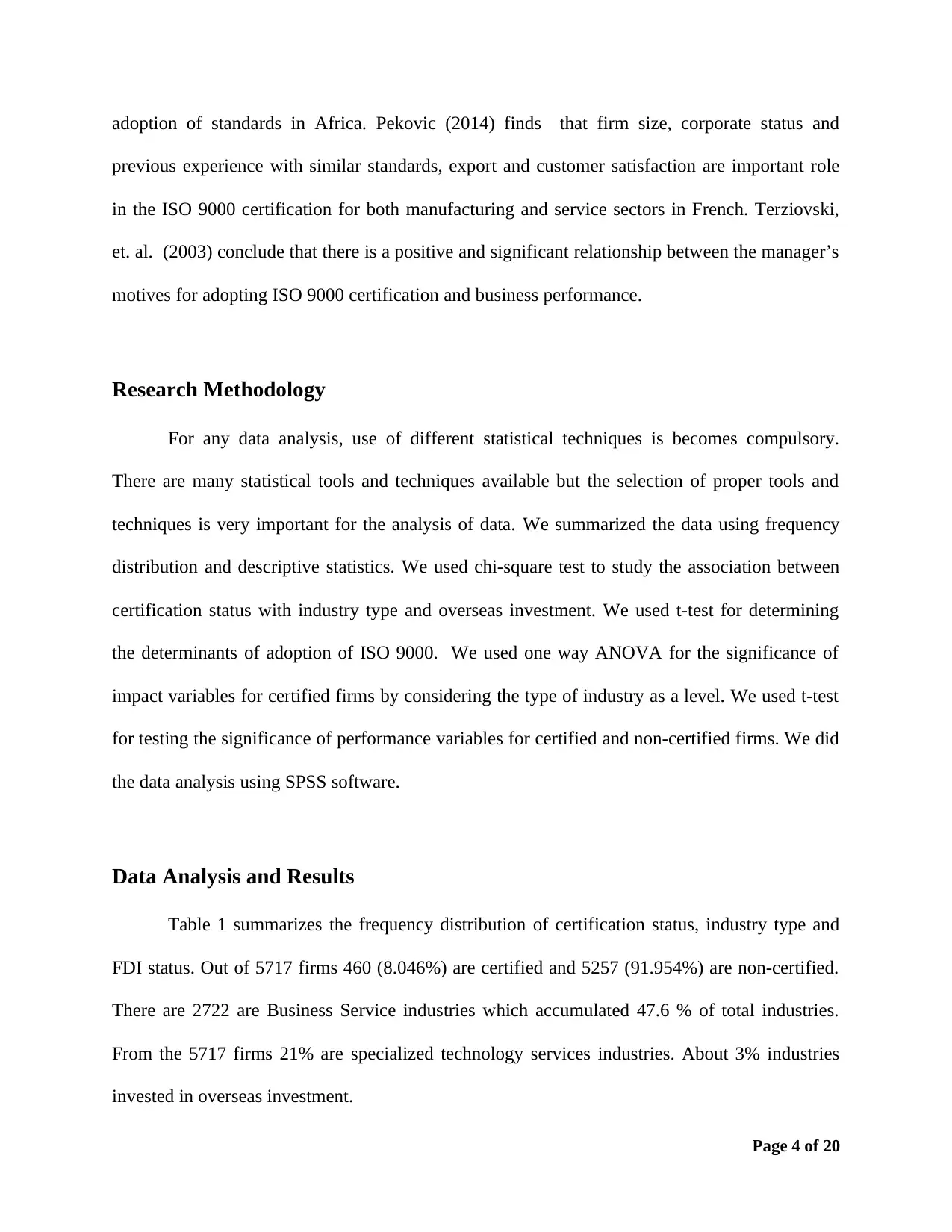
adoption of standards in Africa. Pekovic (2014) finds that firm size, corporate status and
previous experience with similar standards, export and customer satisfaction are important role
in the ISO 9000 certification for both manufacturing and service sectors in French. Terziovski,
et. al. (2003) conclude that there is a positive and significant relationship between the manager’s
motives for adopting ISO 9000 certification and business performance.
Research Methodology
For any data analysis, use of different statistical techniques is becomes compulsory.
There are many statistical tools and techniques available but the selection of proper tools and
techniques is very important for the analysis of data. We summarized the data using frequency
distribution and descriptive statistics. We used chi-square test to study the association between
certification status with industry type and overseas investment. We used t-test for determining
the determinants of adoption of ISO 9000. We used one way ANOVA for the significance of
impact variables for certified firms by considering the type of industry as a level. We used t-test
for testing the significance of performance variables for certified and non-certified firms. We did
the data analysis using SPSS software.
Data Analysis and Results
Table 1 summarizes the frequency distribution of certification status, industry type and
FDI status. Out of 5717 firms 460 (8.046%) are certified and 5257 (91.954%) are non-certified.
There are 2722 are Business Service industries which accumulated 47.6 % of total industries.
From the 5717 firms 21% are specialized technology services industries. About 3% industries
invested in overseas investment.
Page 4 of 20
previous experience with similar standards, export and customer satisfaction are important role
in the ISO 9000 certification for both manufacturing and service sectors in French. Terziovski,
et. al. (2003) conclude that there is a positive and significant relationship between the manager’s
motives for adopting ISO 9000 certification and business performance.
Research Methodology
For any data analysis, use of different statistical techniques is becomes compulsory.
There are many statistical tools and techniques available but the selection of proper tools and
techniques is very important for the analysis of data. We summarized the data using frequency
distribution and descriptive statistics. We used chi-square test to study the association between
certification status with industry type and overseas investment. We used t-test for determining
the determinants of adoption of ISO 9000. We used one way ANOVA for the significance of
impact variables for certified firms by considering the type of industry as a level. We used t-test
for testing the significance of performance variables for certified and non-certified firms. We did
the data analysis using SPSS software.
Data Analysis and Results
Table 1 summarizes the frequency distribution of certification status, industry type and
FDI status. Out of 5717 firms 460 (8.046%) are certified and 5257 (91.954%) are non-certified.
There are 2722 are Business Service industries which accumulated 47.6 % of total industries.
From the 5717 firms 21% are specialized technology services industries. About 3% industries
invested in overseas investment.
Page 4 of 20
Paraphrase This Document
Need a fresh take? Get an instant paraphrase of this document with our AI Paraphraser
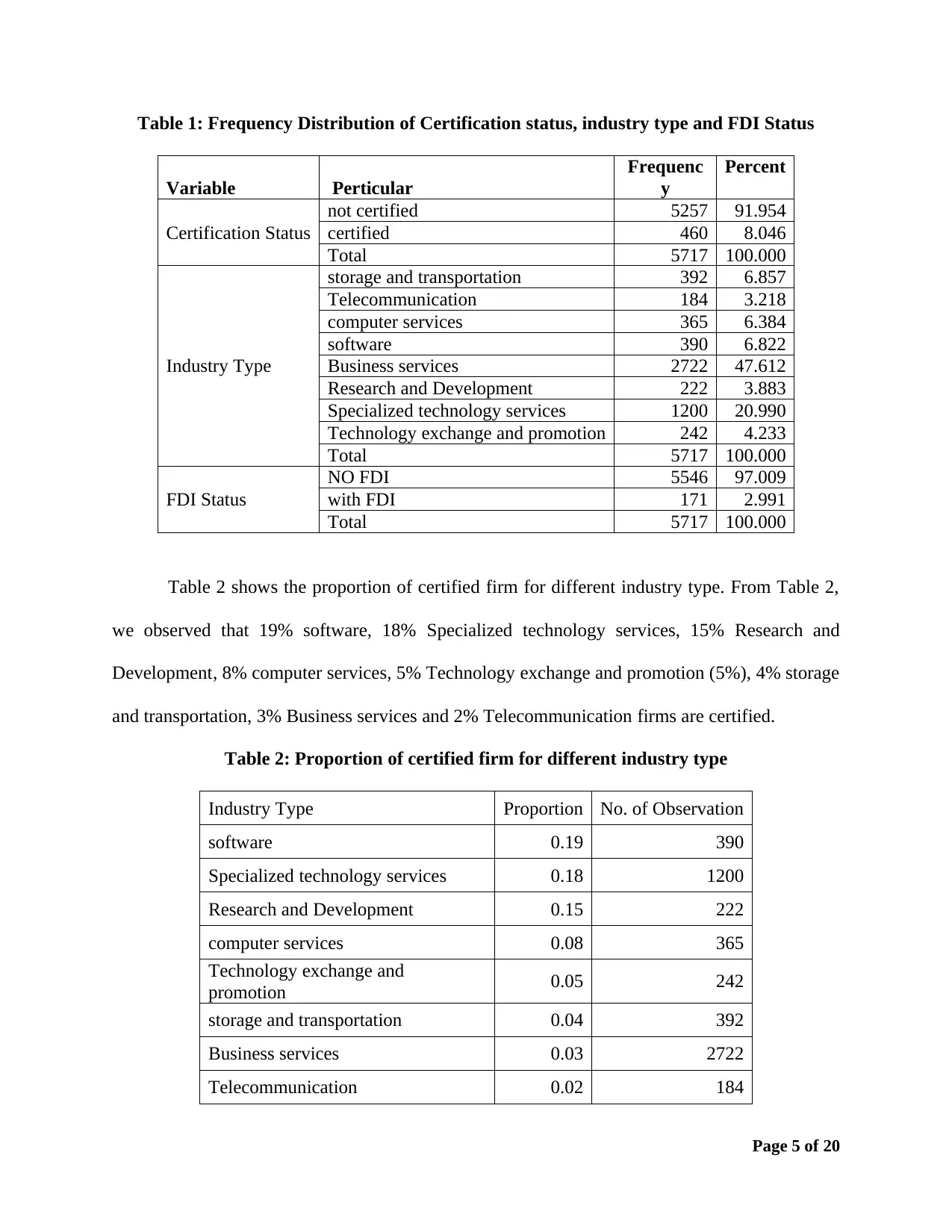
Table 1: Frequency Distribution of Certification status, industry type and FDI Status
Variable Perticular
Frequenc
y
Percent
Certification Status
not certified 5257 91.954
certified 460 8.046
Total 5717 100.000
Industry Type
storage and transportation 392 6.857
Telecommunication 184 3.218
computer services 365 6.384
software 390 6.822
Business services 2722 47.612
Research and Development 222 3.883
Specialized technology services 1200 20.990
Technology exchange and promotion 242 4.233
Total 5717 100.000
FDI Status
NO FDI 5546 97.009
with FDI 171 2.991
Total 5717 100.000
Table 2 shows the proportion of certified firm for different industry type. From Table 2,
we observed that 19% software, 18% Specialized technology services, 15% Research and
Development, 8% computer services, 5% Technology exchange and promotion (5%), 4% storage
and transportation, 3% Business services and 2% Telecommunication firms are certified.
Table 2: Proportion of certified firm for different industry type
Industry Type Proportion No. of Observation
software 0.19 390
Specialized technology services 0.18 1200
Research and Development 0.15 222
computer services 0.08 365
Technology exchange and
promotion 0.05 242
storage and transportation 0.04 392
Business services 0.03 2722
Telecommunication 0.02 184
Page 5 of 20
Variable Perticular
Frequenc
y
Percent
Certification Status
not certified 5257 91.954
certified 460 8.046
Total 5717 100.000
Industry Type
storage and transportation 392 6.857
Telecommunication 184 3.218
computer services 365 6.384
software 390 6.822
Business services 2722 47.612
Research and Development 222 3.883
Specialized technology services 1200 20.990
Technology exchange and promotion 242 4.233
Total 5717 100.000
FDI Status
NO FDI 5546 97.009
with FDI 171 2.991
Total 5717 100.000
Table 2 shows the proportion of certified firm for different industry type. From Table 2,
we observed that 19% software, 18% Specialized technology services, 15% Research and
Development, 8% computer services, 5% Technology exchange and promotion (5%), 4% storage
and transportation, 3% Business services and 2% Telecommunication firms are certified.
Table 2: Proportion of certified firm for different industry type
Industry Type Proportion No. of Observation
software 0.19 390
Specialized technology services 0.18 1200
Research and Development 0.15 222
computer services 0.08 365
Technology exchange and
promotion 0.05 242
storage and transportation 0.04 392
Business services 0.03 2722
Telecommunication 0.02 184
Page 5 of 20
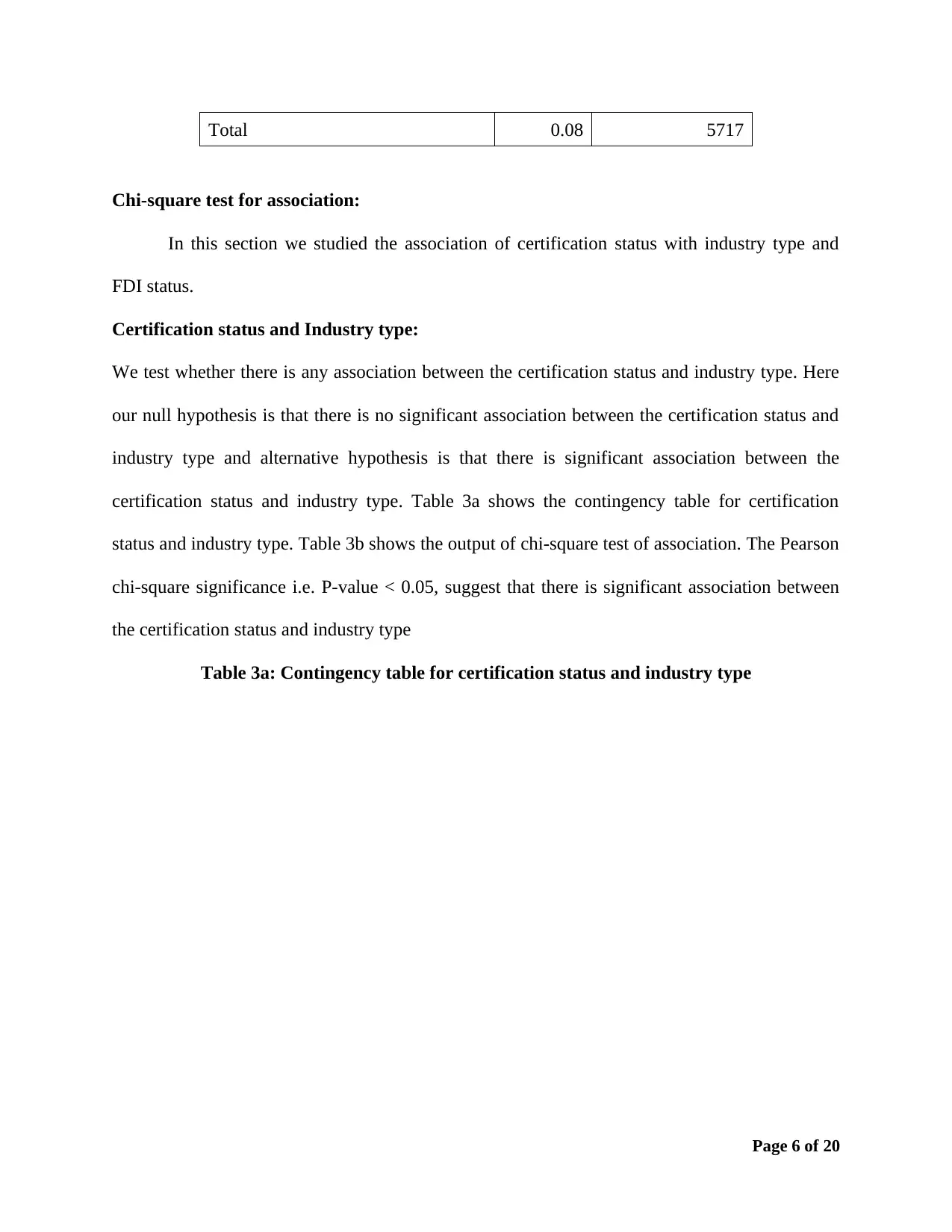
Total 0.08 5717
Chi-square test for association:
In this section we studied the association of certification status with industry type and
FDI status.
Certification status and Industry type:
We test whether there is any association between the certification status and industry type. Here
our null hypothesis is that there is no significant association between the certification status and
industry type and alternative hypothesis is that there is significant association between the
certification status and industry type. Table 3a shows the contingency table for certification
status and industry type. Table 3b shows the output of chi-square test of association. The Pearson
chi-square significance i.e. P-value < 0.05, suggest that there is significant association between
the certification status and industry type
Table 3a: Contingency table for certification status and industry type
Page 6 of 20
Chi-square test for association:
In this section we studied the association of certification status with industry type and
FDI status.
Certification status and Industry type:
We test whether there is any association between the certification status and industry type. Here
our null hypothesis is that there is no significant association between the certification status and
industry type and alternative hypothesis is that there is significant association between the
certification status and industry type. Table 3a shows the contingency table for certification
status and industry type. Table 3b shows the output of chi-square test of association. The Pearson
chi-square significance i.e. P-value < 0.05, suggest that there is significant association between
the certification status and industry type
Table 3a: Contingency table for certification status and industry type
Page 6 of 20
⊘ This is a preview!⊘
Do you want full access?
Subscribe today to unlock all pages.

Trusted by 1+ million students worldwide
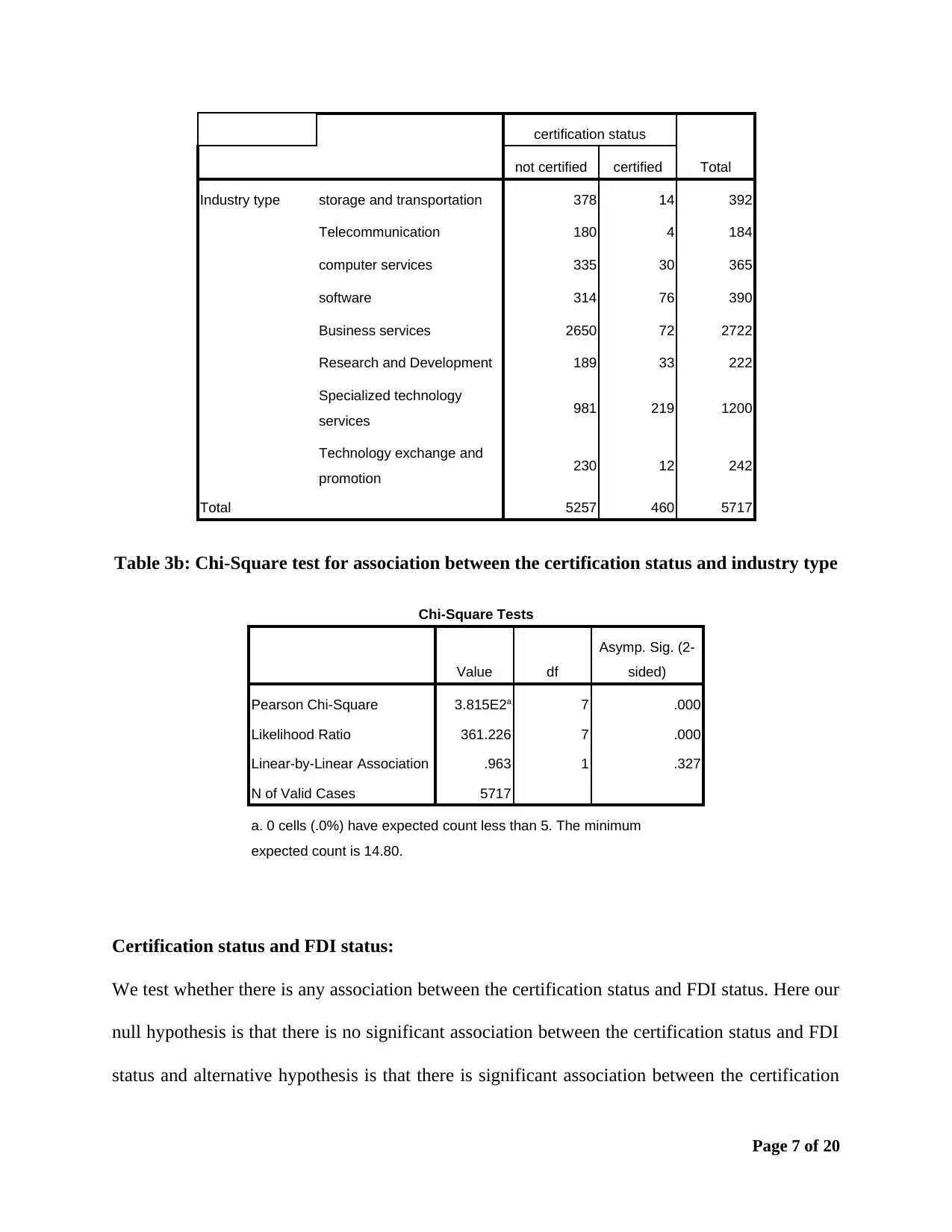
certification status
Totalnot certified certified
Industry type storage and transportation 378 14 392
Telecommunication 180 4 184
computer services 335 30 365
software 314 76 390
Business services 2650 72 2722
Research and Development 189 33 222
Specialized technology
services 981 219 1200
Technology exchange and
promotion 230 12 242
Total 5257 460 5717
Table 3b: Chi-Square test for association between the certification status and industry type
Chi-Square Tests
Value df
Asymp. Sig. (2-
sided)
Pearson Chi-Square 3.815E2a 7 .000
Likelihood Ratio 361.226 7 .000
Linear-by-Linear Association .963 1 .327
N of Valid Cases 5717
a. 0 cells (.0%) have expected count less than 5. The minimum
expected count is 14.80.
Certification status and FDI status:
We test whether there is any association between the certification status and FDI status. Here our
null hypothesis is that there is no significant association between the certification status and FDI
status and alternative hypothesis is that there is significant association between the certification
Page 7 of 20
Totalnot certified certified
Industry type storage and transportation 378 14 392
Telecommunication 180 4 184
computer services 335 30 365
software 314 76 390
Business services 2650 72 2722
Research and Development 189 33 222
Specialized technology
services 981 219 1200
Technology exchange and
promotion 230 12 242
Total 5257 460 5717
Table 3b: Chi-Square test for association between the certification status and industry type
Chi-Square Tests
Value df
Asymp. Sig. (2-
sided)
Pearson Chi-Square 3.815E2a 7 .000
Likelihood Ratio 361.226 7 .000
Linear-by-Linear Association .963 1 .327
N of Valid Cases 5717
a. 0 cells (.0%) have expected count less than 5. The minimum
expected count is 14.80.
Certification status and FDI status:
We test whether there is any association between the certification status and FDI status. Here our
null hypothesis is that there is no significant association between the certification status and FDI
status and alternative hypothesis is that there is significant association between the certification
Page 7 of 20
Paraphrase This Document
Need a fresh take? Get an instant paraphrase of this document with our AI Paraphraser
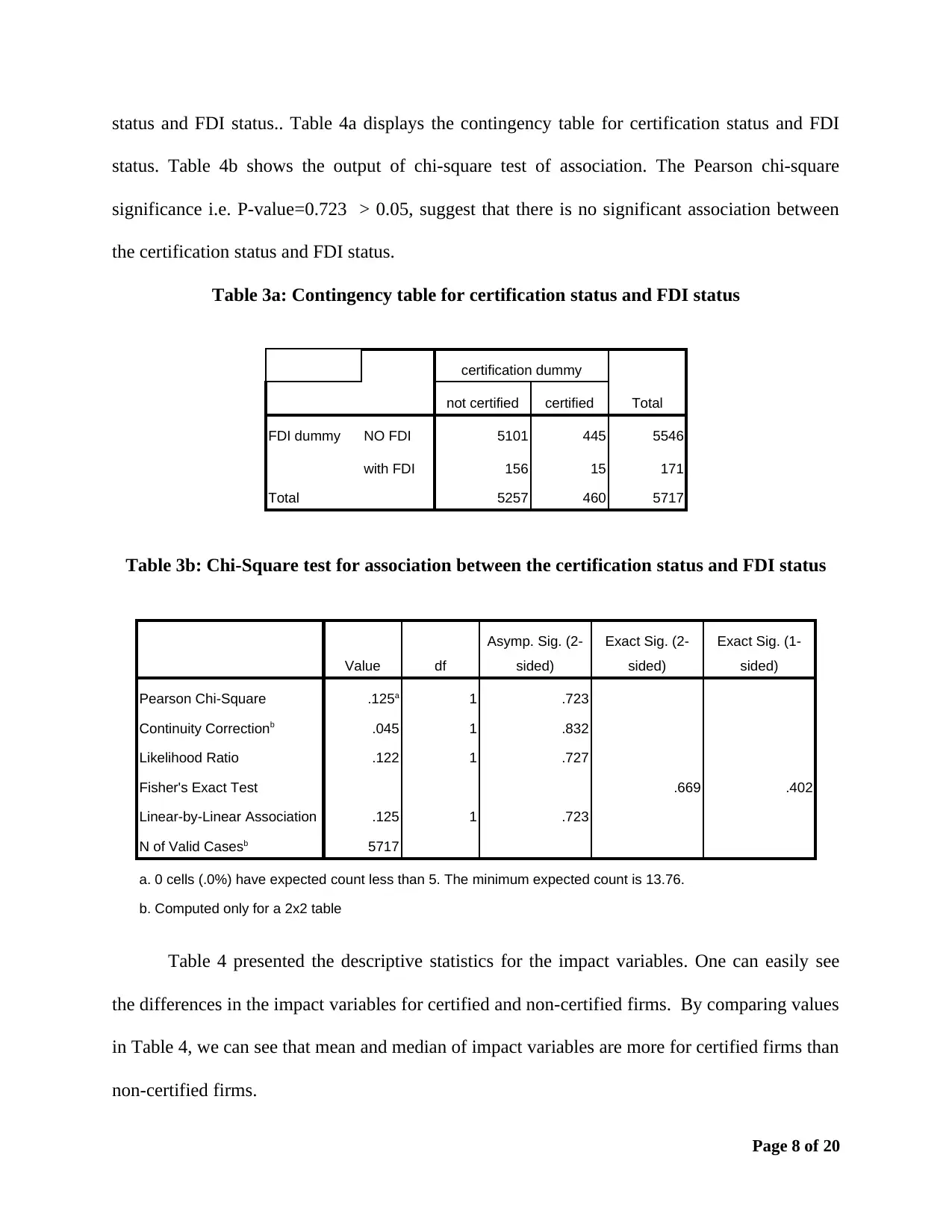
status and FDI status.. Table 4a displays the contingency table for certification status and FDI
status. Table 4b shows the output of chi-square test of association. The Pearson chi-square
significance i.e. P-value=0.723 > 0.05, suggest that there is no significant association between
the certification status and FDI status.
Table 3a: Contingency table for certification status and FDI status
certification dummy
Totalnot certified certified
FDI dummy NO FDI 5101 445 5546
with FDI 156 15 171
Total 5257 460 5717
Table 3b: Chi-Square test for association between the certification status and FDI status
Value df
Asymp. Sig. (2-
sided)
Exact Sig. (2-
sided)
Exact Sig. (1-
sided)
Pearson Chi-Square .125a 1 .723
Continuity Correctionb .045 1 .832
Likelihood Ratio .122 1 .727
Fisher's Exact Test .669 .402
Linear-by-Linear Association .125 1 .723
N of Valid Casesb 5717
a. 0 cells (.0%) have expected count less than 5. The minimum expected count is 13.76.
b. Computed only for a 2x2 table
Table 4 presented the descriptive statistics for the impact variables. One can easily see
the differences in the impact variables for certified and non-certified firms. By comparing values
in Table 4, we can see that mean and median of impact variables are more for certified firms than
non-certified firms.
Page 8 of 20
status. Table 4b shows the output of chi-square test of association. The Pearson chi-square
significance i.e. P-value=0.723 > 0.05, suggest that there is no significant association between
the certification status and FDI status.
Table 3a: Contingency table for certification status and FDI status
certification dummy
Totalnot certified certified
FDI dummy NO FDI 5101 445 5546
with FDI 156 15 171
Total 5257 460 5717
Table 3b: Chi-Square test for association between the certification status and FDI status
Value df
Asymp. Sig. (2-
sided)
Exact Sig. (2-
sided)
Exact Sig. (1-
sided)
Pearson Chi-Square .125a 1 .723
Continuity Correctionb .045 1 .832
Likelihood Ratio .122 1 .727
Fisher's Exact Test .669 .402
Linear-by-Linear Association .125 1 .723
N of Valid Casesb 5717
a. 0 cells (.0%) have expected count less than 5. The minimum expected count is 13.76.
b. Computed only for a 2x2 table
Table 4 presented the descriptive statistics for the impact variables. One can easily see
the differences in the impact variables for certified and non-certified firms. By comparing values
in Table 4, we can see that mean and median of impact variables are more for certified firms than
non-certified firms.
Page 8 of 20
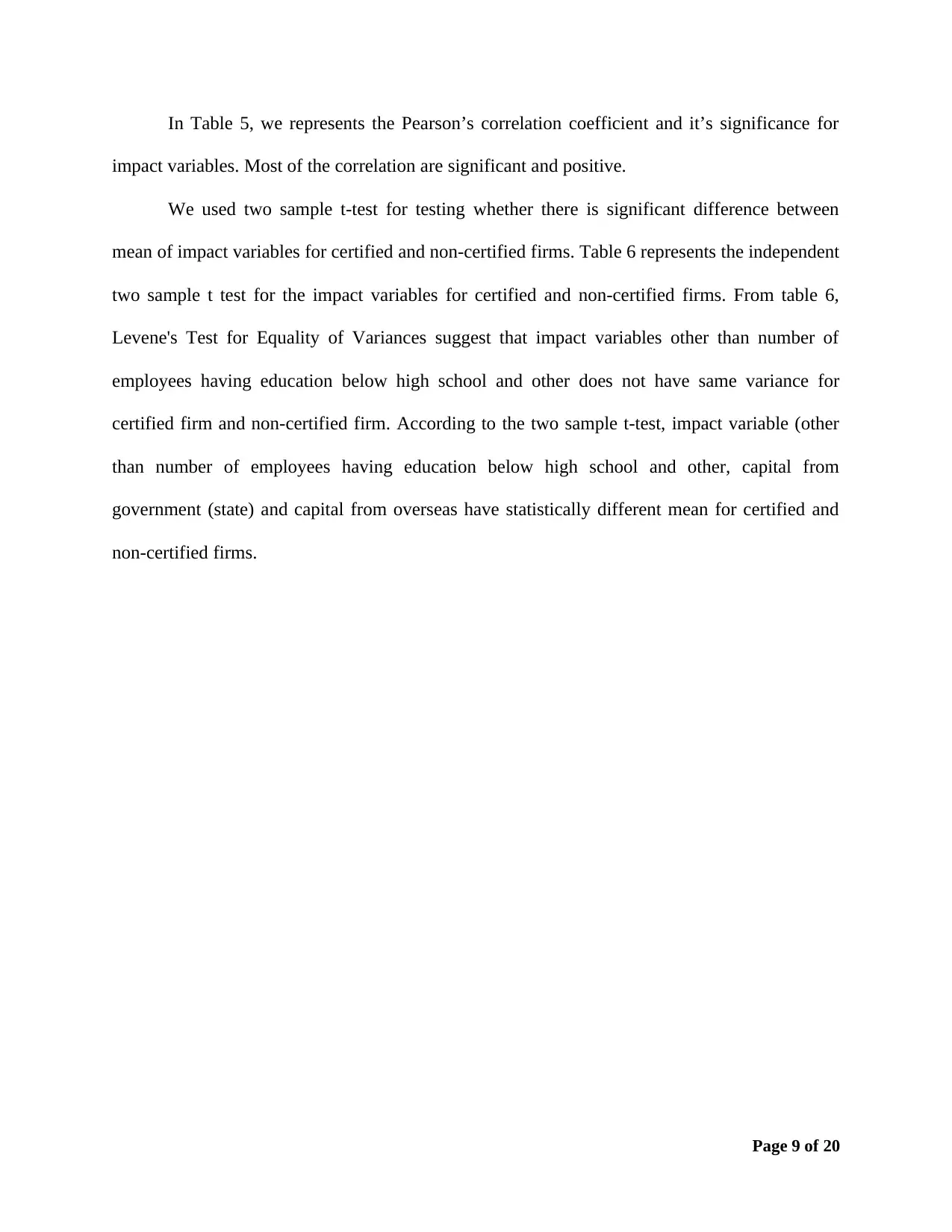
In Table 5, we represents the Pearson’s correlation coefficient and it’s significance for
impact variables. Most of the correlation are significant and positive.
We used two sample t-test for testing whether there is significant difference between
mean of impact variables for certified and non-certified firms. Table 6 represents the independent
two sample t test for the impact variables for certified and non-certified firms. From table 6,
Levene's Test for Equality of Variances suggest that impact variables other than number of
employees having education below high school and other does not have same variance for
certified firm and non-certified firm. According to the two sample t-test, impact variable (other
than number of employees having education below high school and other, capital from
government (state) and capital from overseas have statistically different mean for certified and
non-certified firms.
Page 9 of 20
impact variables. Most of the correlation are significant and positive.
We used two sample t-test for testing whether there is significant difference between
mean of impact variables for certified and non-certified firms. Table 6 represents the independent
two sample t test for the impact variables for certified and non-certified firms. From table 6,
Levene's Test for Equality of Variances suggest that impact variables other than number of
employees having education below high school and other does not have same variance for
certified firm and non-certified firm. According to the two sample t-test, impact variable (other
than number of employees having education below high school and other, capital from
government (state) and capital from overseas have statistically different mean for certified and
non-certified firms.
Page 9 of 20
⊘ This is a preview!⊘
Do you want full access?
Subscribe today to unlock all pages.

Trusted by 1+ million students worldwide
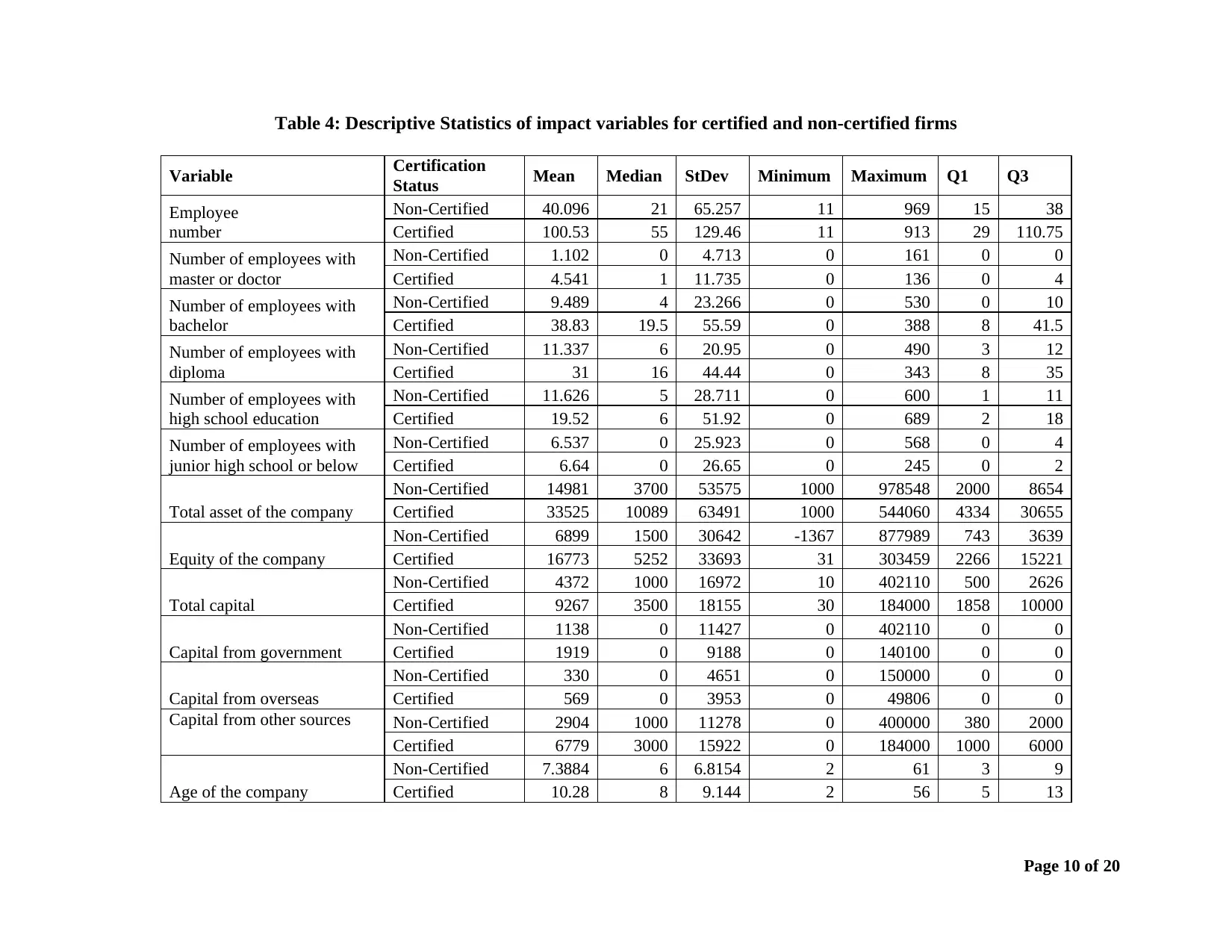
Table 4: Descriptive Statistics of impact variables for certified and non-certified firms
Variable Certification
Status Mean Median StDev Minimum Maximum Q1 Q3
Employee
number
Non-Certified 40.096 21 65.257 11 969 15 38
Certified 100.53 55 129.46 11 913 29 110.75
Number of employees with
master or doctor
Non-Certified 1.102 0 4.713 0 161 0 0
Certified 4.541 1 11.735 0 136 0 4
Number of employees with
bachelor
Non-Certified 9.489 4 23.266 0 530 0 10
Certified 38.83 19.5 55.59 0 388 8 41.5
Number of employees with
diploma
Non-Certified 11.337 6 20.95 0 490 3 12
Certified 31 16 44.44 0 343 8 35
Number of employees with
high school education
Non-Certified 11.626 5 28.711 0 600 1 11
Certified 19.52 6 51.92 0 689 2 18
Number of employees with
junior high school or below
Non-Certified 6.537 0 25.923 0 568 0 4
Certified 6.64 0 26.65 0 245 0 2
Total asset of the company
Non-Certified 14981 3700 53575 1000 978548 2000 8654
Certified 33525 10089 63491 1000 544060 4334 30655
Equity of the company
Non-Certified 6899 1500 30642 -1367 877989 743 3639
Certified 16773 5252 33693 31 303459 2266 15221
Total capital
Non-Certified 4372 1000 16972 10 402110 500 2626
Certified 9267 3500 18155 30 184000 1858 10000
Capital from government
Non-Certified 1138 0 11427 0 402110 0 0
Certified 1919 0 9188 0 140100 0 0
Capital from overseas
Non-Certified 330 0 4651 0 150000 0 0
Certified 569 0 3953 0 49806 0 0
Capital from other sources Non-Certified 2904 1000 11278 0 400000 380 2000
Certified 6779 3000 15922 0 184000 1000 6000
Age of the company
Non-Certified 7.3884 6 6.8154 2 61 3 9
Certified 10.28 8 9.144 2 56 5 13
Page 10 of 20
Variable Certification
Status Mean Median StDev Minimum Maximum Q1 Q3
Employee
number
Non-Certified 40.096 21 65.257 11 969 15 38
Certified 100.53 55 129.46 11 913 29 110.75
Number of employees with
master or doctor
Non-Certified 1.102 0 4.713 0 161 0 0
Certified 4.541 1 11.735 0 136 0 4
Number of employees with
bachelor
Non-Certified 9.489 4 23.266 0 530 0 10
Certified 38.83 19.5 55.59 0 388 8 41.5
Number of employees with
diploma
Non-Certified 11.337 6 20.95 0 490 3 12
Certified 31 16 44.44 0 343 8 35
Number of employees with
high school education
Non-Certified 11.626 5 28.711 0 600 1 11
Certified 19.52 6 51.92 0 689 2 18
Number of employees with
junior high school or below
Non-Certified 6.537 0 25.923 0 568 0 4
Certified 6.64 0 26.65 0 245 0 2
Total asset of the company
Non-Certified 14981 3700 53575 1000 978548 2000 8654
Certified 33525 10089 63491 1000 544060 4334 30655
Equity of the company
Non-Certified 6899 1500 30642 -1367 877989 743 3639
Certified 16773 5252 33693 31 303459 2266 15221
Total capital
Non-Certified 4372 1000 16972 10 402110 500 2626
Certified 9267 3500 18155 30 184000 1858 10000
Capital from government
Non-Certified 1138 0 11427 0 402110 0 0
Certified 1919 0 9188 0 140100 0 0
Capital from overseas
Non-Certified 330 0 4651 0 150000 0 0
Certified 569 0 3953 0 49806 0 0
Capital from other sources Non-Certified 2904 1000 11278 0 400000 380 2000
Certified 6779 3000 15922 0 184000 1000 6000
Age of the company
Non-Certified 7.3884 6 6.8154 2 61 3 9
Certified 10.28 8 9.144 2 56 5 13
Page 10 of 20
Paraphrase This Document
Need a fresh take? Get an instant paraphrase of this document with our AI Paraphraser
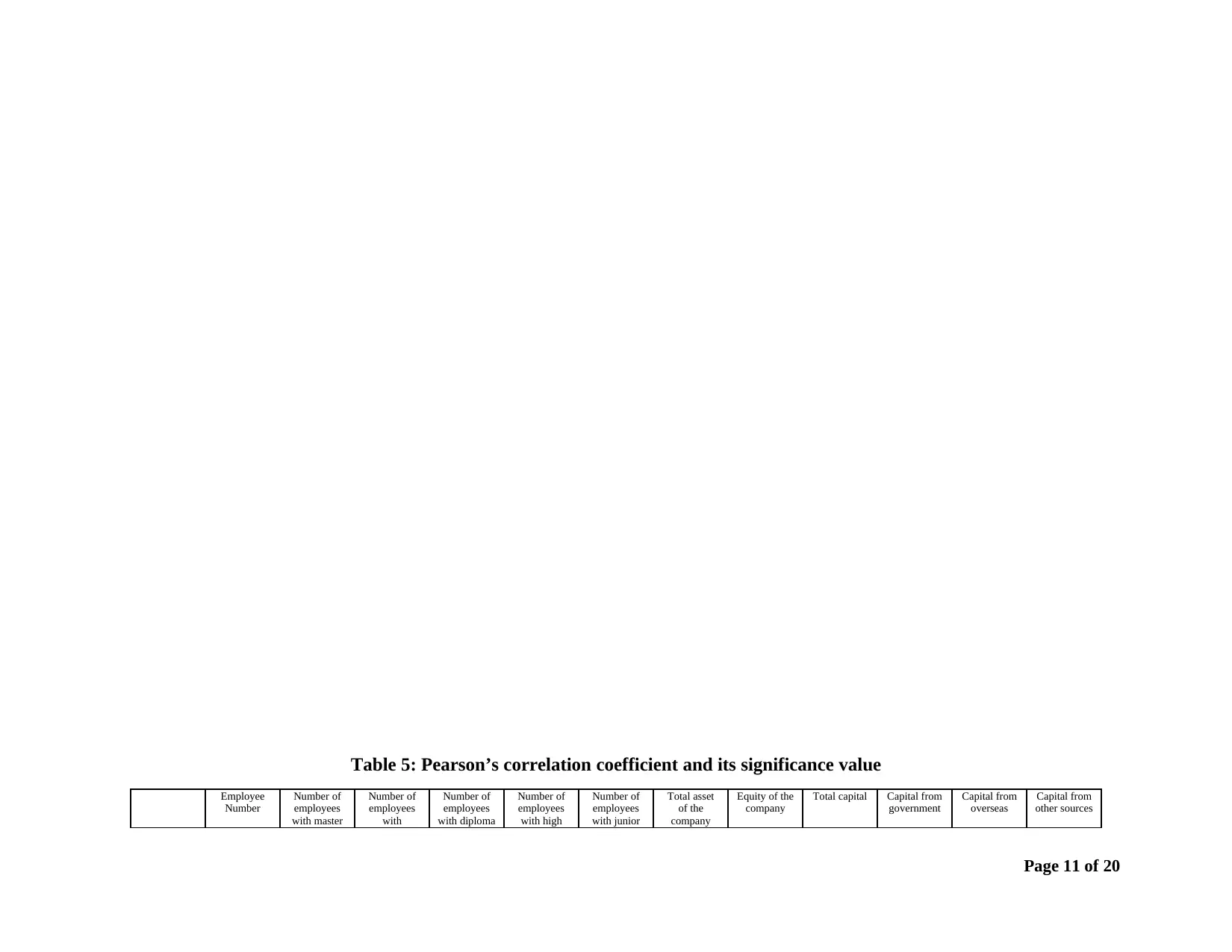
Table 5: Pearson’s correlation coefficient and its significance value
Employee
Number
Number of
employees
with master
Number of
employees
with
Number of
employees
with diploma
Number of
employees
with high
Number of
employees
with junior
Total asset
of the
company
Equity of the
company
Total capital Capital from
government
Capital from
overseas
Capital from
other sources
Page 11 of 20
Employee
Number
Number of
employees
with master
Number of
employees
with
Number of
employees
with diploma
Number of
employees
with high
Number of
employees
with junior
Total asset
of the
company
Equity of the
company
Total capital Capital from
government
Capital from
overseas
Capital from
other sources
Page 11 of 20
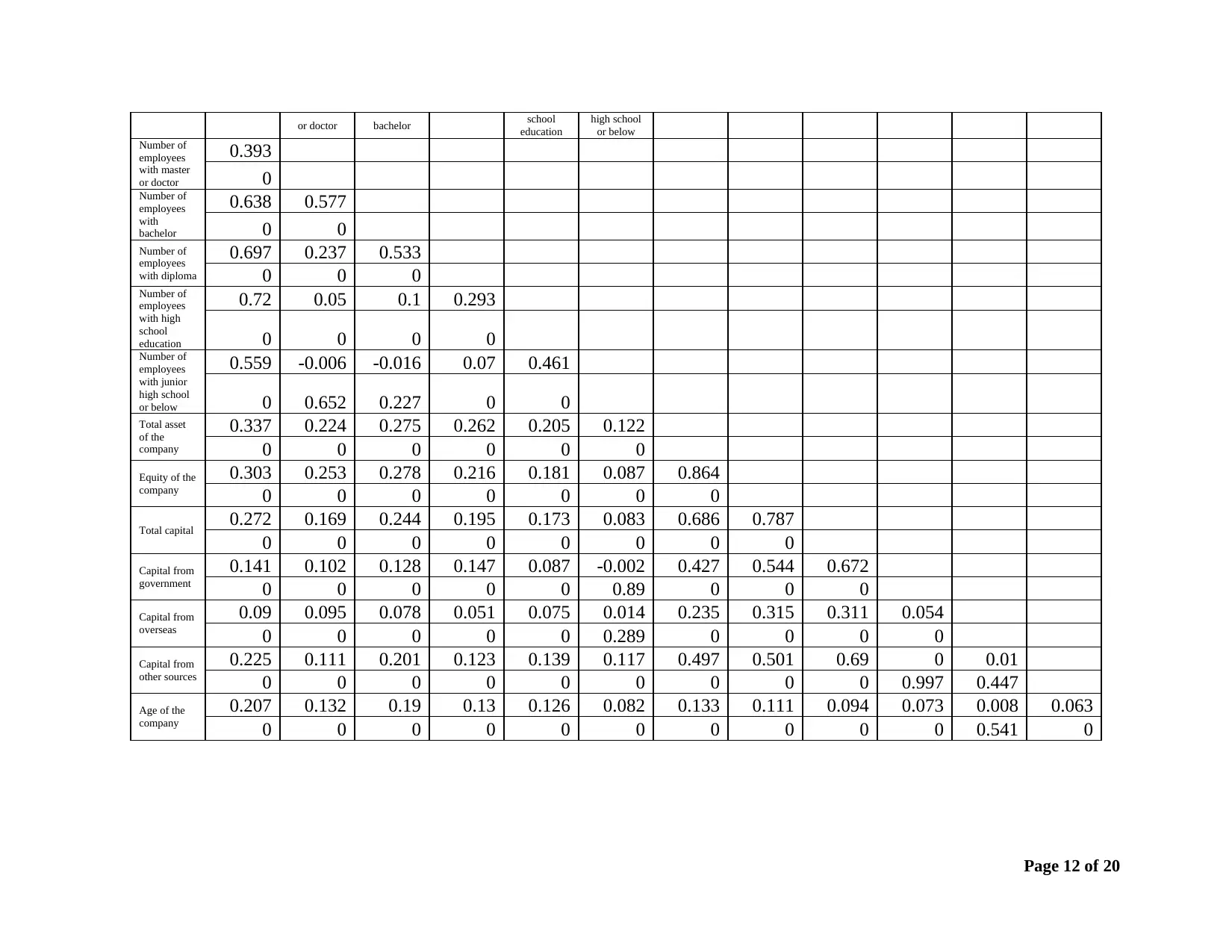
or doctor bachelor school
education
high school
or below
Number of
employees
with master
or doctor
0.393
0
Number of
employees
with
bachelor
0.638 0.577
0 0
Number of
employees
with diploma
0.697 0.237 0.533
0 0 0
Number of
employees
with high
school
education
0.72 0.05 0.1 0.293
0 0 0 0
Number of
employees
with junior
high school
or below
0.559 -0.006 -0.016 0.07 0.461
0 0.652 0.227 0 0
Total asset
of the
company
0.337 0.224 0.275 0.262 0.205 0.122
0 0 0 0 0 0
Equity of the
company
0.303 0.253 0.278 0.216 0.181 0.087 0.864
0 0 0 0 0 0 0
Total capital 0.272 0.169 0.244 0.195 0.173 0.083 0.686 0.787
0 0 0 0 0 0 0 0
Capital from
government
0.141 0.102 0.128 0.147 0.087 -0.002 0.427 0.544 0.672
0 0 0 0 0 0.89 0 0 0
Capital from
overseas
0.09 0.095 0.078 0.051 0.075 0.014 0.235 0.315 0.311 0.054
0 0 0 0 0 0.289 0 0 0 0
Capital from
other sources
0.225 0.111 0.201 0.123 0.139 0.117 0.497 0.501 0.69 0 0.01
0 0 0 0 0 0 0 0 0 0.997 0.447
Age of the
company
0.207 0.132 0.19 0.13 0.126 0.082 0.133 0.111 0.094 0.073 0.008 0.063
0 0 0 0 0 0 0 0 0 0 0.541 0
Page 12 of 20
education
high school
or below
Number of
employees
with master
or doctor
0.393
0
Number of
employees
with
bachelor
0.638 0.577
0 0
Number of
employees
with diploma
0.697 0.237 0.533
0 0 0
Number of
employees
with high
school
education
0.72 0.05 0.1 0.293
0 0 0 0
Number of
employees
with junior
high school
or below
0.559 -0.006 -0.016 0.07 0.461
0 0.652 0.227 0 0
Total asset
of the
company
0.337 0.224 0.275 0.262 0.205 0.122
0 0 0 0 0 0
Equity of the
company
0.303 0.253 0.278 0.216 0.181 0.087 0.864
0 0 0 0 0 0 0
Total capital 0.272 0.169 0.244 0.195 0.173 0.083 0.686 0.787
0 0 0 0 0 0 0 0
Capital from
government
0.141 0.102 0.128 0.147 0.087 -0.002 0.427 0.544 0.672
0 0 0 0 0 0.89 0 0 0
Capital from
overseas
0.09 0.095 0.078 0.051 0.075 0.014 0.235 0.315 0.311 0.054
0 0 0 0 0 0.289 0 0 0 0
Capital from
other sources
0.225 0.111 0.201 0.123 0.139 0.117 0.497 0.501 0.69 0 0.01
0 0 0 0 0 0 0 0 0 0.997 0.447
Age of the
company
0.207 0.132 0.19 0.13 0.126 0.082 0.133 0.111 0.094 0.073 0.008 0.063
0 0 0 0 0 0 0 0 0 0 0.541 0
Page 12 of 20
⊘ This is a preview!⊘
Do you want full access?
Subscribe today to unlock all pages.

Trusted by 1+ million students worldwide
1 out of 20
Related Documents
Your All-in-One AI-Powered Toolkit for Academic Success.
+13062052269
info@desklib.com
Available 24*7 on WhatsApp / Email
![[object Object]](/_next/static/media/star-bottom.7253800d.svg)
Unlock your academic potential
Copyright © 2020–2026 A2Z Services. All Rights Reserved. Developed and managed by ZUCOL.




